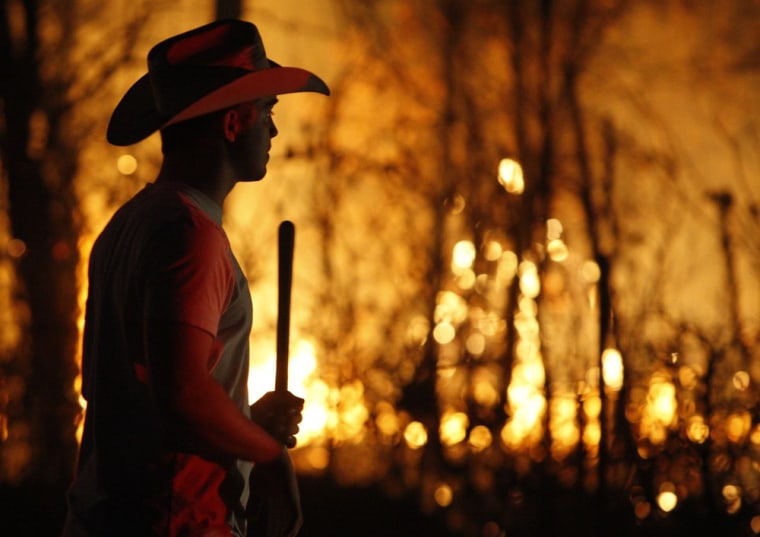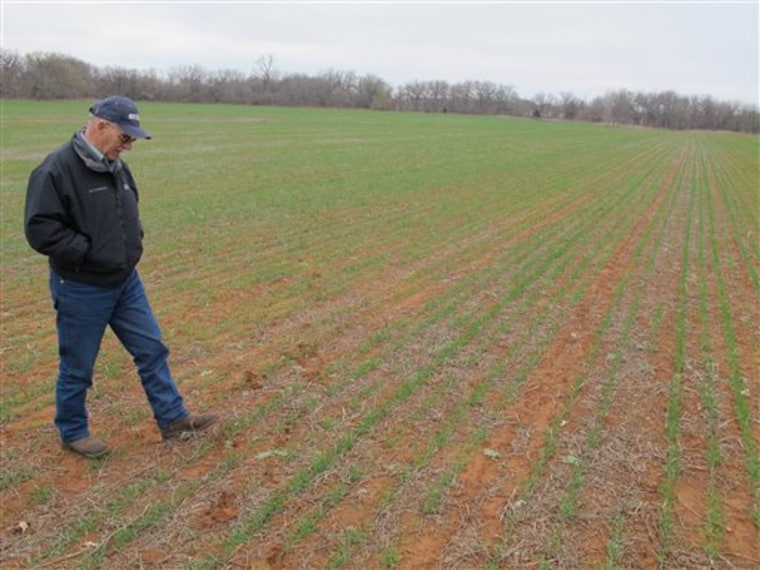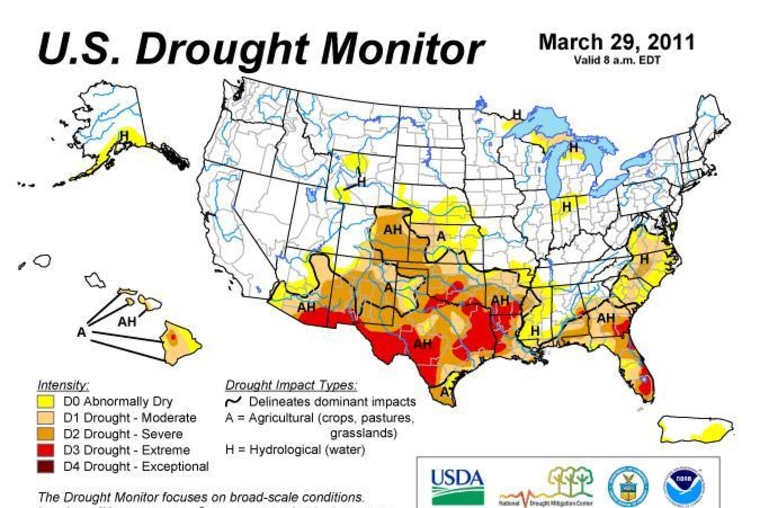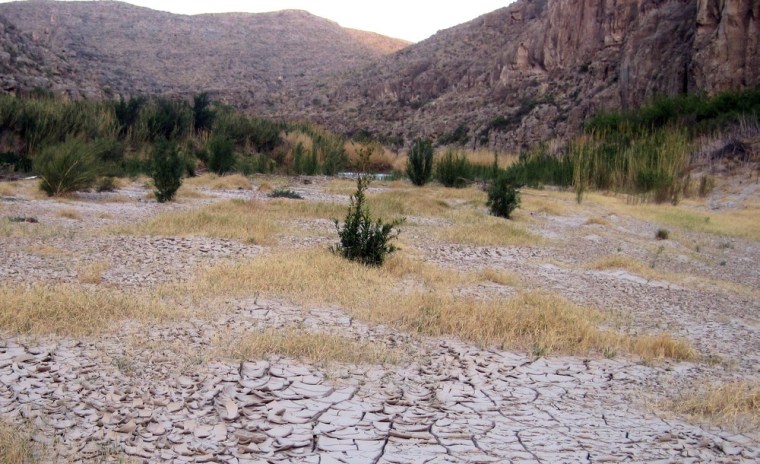In most years, the dark clouds over western Oklahoma in the spring would be bringing rain. This year, they're more likely to be smoke from wildfires that have burned thousands of acres in the past month as the state and its farmers struggle with a severe drought.
Oklahoma was drier in the four months following Thanksgiving than it has been in any similar period since 1921. That's saying a lot in the state known for the 1930s Dust Bowl, when drought, destructive farming practices and high winds generated severe dust storms that stripped the land of its topsoil.
Neighboring states are in similar shape as the drought stretches from the Louisiana Gulf coast to Colorado, and conditions are getting worse, according to the U.S. Drought Monitor. The area in Texas covered by an extreme drought has tripled in the past month to 40 percent, and in Oklahoma it nearly doubled in one week to 16 percent, according to the monitor's March 29 update.
"Many drought indicators in east-central Texas have reached the Exceptional Drought (D4) level, and if rain does not materialize soon, intensification of the current drought is likely," the update stated. "The remaining drought regions in northern and central Texas continued to depict worsening conditions as well, as the lingering benefits of late-winter rainfall quickly give way to dry, hot weather."
An extreme drought is declared when there's major damage to crops or pasture and widespread water shortages or restrictions.

While dozens of people in Kansas, Oklahoma and Texas have lost homes to the hundreds of grassfires that have torn through the parched landscape in the past month, Oklahoma officials said more fires caused more damage as recently as 2009. This year, the biggest losses are likely to come from the drought's effect on the wheat farmers planted last fall and hoped to harvest in June, they said.
Oklahoma: Grass 'like gasoline'
Almost all of Oklahoma is covered in some degree of drought. Only the far northeastern corner has escaped, thanks to a few big winter snowstorms.
On Jim Freudenberger's 1,500-acre farm in Coyle, only puny tufts of green poke through much of the topsoil. Freudenberger, 73, said he's weathered several droughts and floods in his decades of farming, and he's still hoping for enough rain in the next two months to save his crop.
But even if it comes, he said, the result's likely to be a crapshoot: One of his fields was covered in foot-tall wheat and could be saved, but the plants in another field about 3 miles away had barely emerged late last month.
"If it doesn't do anything else, it'll make some hay," he said.

Mike Spradling, the president of the Oklahoma Farm Bureau, said many wheat farmers have considered just plowing under their fields and switching to another crop.
Associate state climatologist Gary McManus said conditions have actually gotten worse since crops began emerging. The plants have rapidly sucked up the limited moisture in the soil.
"Some places have already lost their wheat crop farther south and in the Panhandle," he said. "In the driest parts of the state, the rainfall they have gotten, it's not enough to make them rest easy with their crops. It's just a bad situation."
Paul Fruendt said he's been farming for 25 years and he's never seen such bad growing conditions. His farm in Guthrie in central Oklahoma got a little rain, but he said his crops will still probably run out of water within a few weeks.
"For us already, we're going to suffer," said Fruendt, who invested about $100,000 in his wheat. "Probably two-thirds of our gross income has been wiped out for the next six months."
Ranchers in western Oklahoma are worried about their land too. Monte Tucker, 36, a volunteer firefighter and cattle rancher who lives in Sweetwater near the Texas border, said the grass and brush on his property are like tinder. He saw 1,500 of his 5,000 acres burn a few years ago, and without rain, it could easily happen again this year.
"Right now, it's like gasoline," he said of his land.

Texas: Odds of rain 'below normal'
Weather forecasters expect the drought in Texas to continue or get worse through June in most of the state. That means the danger of fire will remain extremely high, National Weather Service meteorologist Victor Murphy said.
"This could end up being one of the more devastating droughts, agriculturally speaking and for wildfires, if we don't start getting normal to above normal rainfall before June," Murphy said. "The odds of seeing that are likely below normal."
Texas hasn't had a drier October to February period since 1967, state climatologist John Nielsen-Gammon said. The five months that ended Feb. 28 saw only 4.8 inches of rain on average across the state. In a typical year, an average of 9.7 inches would fall.
The drought has been made worse by warmer than normal temperatures, said Travis Miller, a drought specialist with Texas AgriLife Extension Service.
On Sunday, low humidity and winds up to 55 mph fueled the spread of wildfires across West Texas, and four big ones burned more than 11,000 acres. Some of the fires continued to burn Monday, but they were nothing like the day before, Texas Forest Service spokesman Alan Craft said. Nearly 180 of Texas' 254 counties have burn bans.
Texas is the nation's No. 2 grower of winter wheat, and the drought has hit that crop hard. More than 60 percent of the state's winter wheat crop was in poor to very poor condition at the end of March, according to the U.S. Department of Agriculture.
As examples, Midland got .1 inches of rain in March, while College Station got 6 inches. Usually, those cities would get 4.6 and 19.1 inches respectively.
"Even it rains now it wouldn't do much for it," said Miller, the drought specialist. "It'll be a little better. Instead of dying, it might be worth running a combine through."
Bobby McKnight, who has a ranch in far West Texas, said he's doing OK right now because he still has hay from last summer to feed his cattle. But if no new rain comes, feed could be a problem as the year goes on.
"It's pretty tough," said McKnight, 50. "The only thing that makes this bearable it we got a good June and July. We made some grass."
